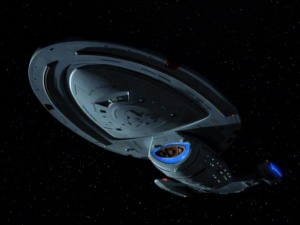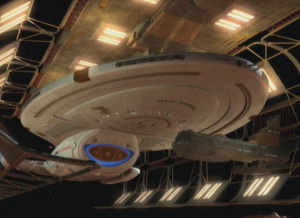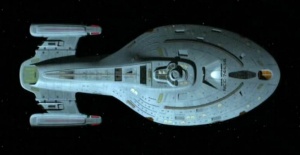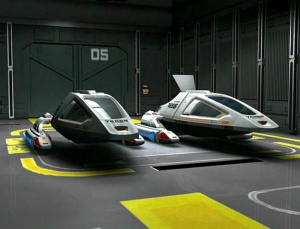Intrepid-class

The Intrepid-class starship was a Federation design that entered service in the latter half of the 24th century.
Example: The USS Voyager was of this class.
Class History

Utopia Planitia Fleet Yards
Development and construction of the Intrepid-class occurred at the Utopia Planitia Fleet Yards, with the class entering service by 2370.
When first commissioned, the Intrepid-class featured many innovations that were just becoming available, including the tricyclic input manifold of the warp core, bioneural gel packs, and was equipped with the Mark 1 Emergency Medical Hologram system. The class boasted the best navigational sensors, and the highest top speed of any Star Fleet vessel until the development of the Prometheus-class.
Technical Data
One of the few Star Fleet starship classes capable of atmospheric entry and planetary landing, the Intrepid-class starship was equipped with anti-gravity generators. Prior to, and during landing or takeoff procedures, the vessel typically went to an alert status, indicating to the crew they were to assume their stations.
Main engineering aboard an Intrepid-class starship was constructed around the matter-antimatter reaction assembly (also known simply as the warp core), featuring two levels. A second tier ringed the upper level of main engineering. A small, single-person elevator, as well as a ladder on the opposite side, provided access to this catwalk.
In the event of a warp core breach, the Intrepid-class starship could eject the warp core. This procedure required the authorization code of the chief engineer or a member of the senior staff. Under normal circumstances, the vessel then moved away from the core as fast as possible under impulse power. Should the core not go critical, the vessel could recover it with tractor beams and careful manipulation.
The Intrepid-class housed five standard torpedo launchers.
The Intrepid-class' deflector shield was a symmetrical, oscillating subspace graviton field. During combat, the shield sent data on what type of weapon was being used on it and what frequency and phase the weapon used. Once the tactical officer analyzed these data, the shield could be configured to have the same frequency as the incoming weapon, but different nutation. This tactic dramatically increased shield efficiency. There were a total of fourteen shield grids on the Intrepid-class.
Support Systems
There was one large sickbay facility, equipped with an intensive-care unit (ICU), biohazard support, critical care, a morgue, the chief medical officer's office, a load-out of three standard biobeds and one surgical bed in the main ward, and a small medical laboratory. The standard medical staff consisted of a doctor and a nurse, supplemented by the Emergency Medical Hologram, the Intrepid-class being one of the first to be equipped with this medical technology.
The Intrepid-class featured three transporter facilities. In case of emergencies, injured personnel could be directly transported to sickbay from anywhere in transporter range, including inside the ship.
The main shuttlebay was the primary port, as well as management, of auxiliary craft and shuttles.
The Intrepid-class starship was typically equipped with the following types of shuttlecraft:

